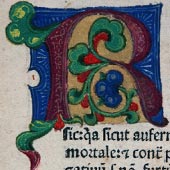Initials: In the beginning...

The term 'initial' is derived from the Latin initiālis and refers to a, or the, beginning of something. Medieval monastic scribes decorated the first letter - the initial - of words that began each section of a manuscript text. These decorated initials functioned as both a form of basic punctuation and as a visual representation of God. Using gold leaf and coloured inks, decorating initials and illuminating manuscripts was raised to an art form. The introduction of printing presses in the early 1400's saw the demise of the manuscript initial and the development of the printed initial as a purely decorative element of a text. Printed initials were sourced from decorative alphabets designed and produced as woodcut, metal-cut, and engraved type for printing presses. Although somewhat modified from its original form and function, through continual adaptation and revival printers have maintained the tradition of the decorative initial. Today, it is most often seen in printed texts as an enlarged, bold, capital letter.
This exhibition briefly highlights the Western European tradition of decorative initials, from early illuminated manuscripts to modern press productions. Included on display are examples of historiated, inhabited, arabesque, puzzle, and passe-partout initials from France, England, Germany, and Italy. Featured in the exhibition are initials designed by William Cowper, William Morris and Eric Gill, as well as illuminated manuscript initials from bibles, a 'Book of Hours', and a sermon book.
This exhibition entitled Initials: In the Beginning… runs from 17th October 2007 until 14th December 2007.

